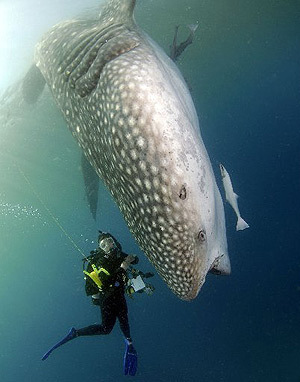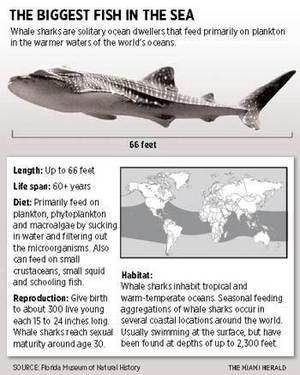So when dive boat captain Jeff Torode heard Sunday afternoon that a 30-foot whale shark was spotted off the coast of Boca Raton, he steered the Aqua View toward the sighting. The placid, filter-feeding sharks are not rare, but it is uncommon for divers to see them because they prefer deep water.

|
| ©Joe Marino |
| A dead whale shark encountered Sunday off South Florida by divers out of Pompano Beach. |
By the time the boat arrived, the whale shark was no longer alive -- it had probably been dead for at least a day. But curious for a closer look, dive instructor Terri Coburn and photographer Joe Marino jumped in to see if they could determine why the massive fish had died. Torode kept the other divers on board, just in case the carcass had attracted scavenger sharks.
Even from aboard the ship, though, it was an amazing view, said diver Pete Sparkman, a tourist from St. Louis.
''You could see the middle portion. It was curved, like a parabola basically,'' Sparkman said. ''You could see maybe five, 10 feet of it, on the surface. Then the tail dipped down on one side and the head was on the other. You could see some small sharks swimming around, but I don't think anything had bitten it yet.''
Marino, a fervent recreational diver who never forgets his Nikon D-200, described swimming around the fish as unlike any of his previous underwater experiences.
''If it was alive, I think the feeling would have been just sheer exhilaration,'' Marino said. ''The fact that it was dead kind of hurt, personally, because here was this magnificent creature of nature that we were blessed to see and we never really had the opportunity to watch it swim on its own.''
No one knows why the shark died. It didn't appear to be injured or look as though it had been rammed by a boat, Marino said.
The sharks are federally protected, but not particularly rare. They are not common in Florida, and it is even more unusual for divers to see them so near to shore, said Bob Hueter, director of the Center for Shark Research at Mote Marine Laboratory in Sarasota.
The last time a dead whale shark was sighted was 2001, when a 20-foot specimen was found headless in the turning basin of Port Everglades and was towed by the Coast Guard six miles out to sea.
Torode said he was told Monday afternoon that the city of Boca Raton may have paid a salvage company to tow the carcass farther off shore so it wouldn't wash up onto municipal beaches. City officials couldn't confirm the report, saying only that they're trying to sort out what has happened.
FLOATING ON
''The last I heard it was floating off Lantana, in about 250 feet of water, heading north,'' Torode said.
The fish are called whale sharks because they look like whales, said José Castro, a fisheries biologist with the National Oceanic and Atmospheric Administration. Despite the names, they are, in fact, fish. Like all sharks, they have cartilaginous skeletons, not bone, Castro said.
Diving with whale sharks is a magical experience, said Hueter, whose study of the creatures has taken him to Dubai and Mexico's Yucatán peninsula.
''It's life-changing,'' Hueter said. ''It's the last place on the planet in the wild where you can be that close to such an animal and be without any risk. These guys are so benign and gentle and graceful. Just to be swimming along this 40-foot long, many-tonned animal, and to have it be aware of you, is just a marvelous experience.''
LIFE CYCLE REVEALED
It wasn't until about 10 years ago when scientists found a female whale shark in Taiwan that they learned how whale sharks ''pupped'' their young, Castro said.
Like all sharks, male and females mate, Hueter said. Female sharks hold the eggs until the young develop and give birth to a brood of as many as 300 at a time. At birth, young whale sharks are about two-feet long -- and completely independent of their mother.

|
| ©Miami Herald |
| Source: Florida Museum of Natural History |
They're filter feeders that eat mostly plankton, so they aren't a threat to humans in their rare encounters.
Because the fish spotted by divers this week has been dead for several days, it has little value for research and will probably be allowed to decompose at sea. Although it's impossible to know how it died without close study, Hueter said, it's likely it was injured by a boat. In his research, he's seen some whale sharks with scars and missing pieces of their fins.
So the whale shark's death will remain a mystery, known only to the sea. And divers like Marino will continue their quest to see one of the live behemoths.
''It's very rare, when you're diving, to be in the presence of something so magnificent,'' Marino said. ''It really puts you in your place as a human, that you're really only so big, so strong. And that nature is all that much greater than yourself. And we're not going to tame it.''



Reader Comments
to our Newsletter